AMD’s Radeon HD 6870 & 6850: Renewing Competition in the Mid-Range Market
by Ryan Smith on October 21, 2010 10:08 PM ESTLast but not least in our look at AMD’s new Radeon 6800 series is our look at power consumption, GPU temperatures, and the amount of noise generated. With efficiency being one of the major design goals for Barts, AMD stands to gain a lot of ground here compared to the 5800 series for only a minor drop in performance.
Looking quickly at the voltages of the 6800 series, we have 4 samples – 2 each of the 6870, and 2 each of the 6850. Both of our 6870 cards have an idle voltage of 0.945v and a load voltage of 1.172v, and seeing as how they’re both based on AMD’s reference design this is what we would expect for a design that is based around a single VID.
However our 6850 results, which include a non-reference card in the form of XFX’s customized 6850, are much more interesting. While our reference 6850 has a load voltage of 1.094v, our XFX card reports a load voltage of 1.148v. We’ll be taking a look at the XFX 6850 in-depth next week in our 6850 roundup, but for now this leaves us with the question of whether AMD is using variable VIDs, or if XFX is purposely setting theirs higher for overclocking purposes.
| Radeon HD 6800 Series Load Voltage | |||||
| Ref 6870 | XFX 6870 | Ref 6850 | XFX 6850 | ||
| 1.172v | 1.172v | 1.094v | 1.148v | ||
Finally our EVGA GTX 460 1GB FTW card has a VID of 0.975v, which compared to all the other GTX 460 cards we’ve tested thus far makes it quite notable. This is lower than any of those other cards by 0.012v, a property we believe is necessary to sell such a heavily overclocked card without causing a similarly large rise in power/heat/noise. It’s also for this reason that we question whether NVIDIA could actually supply suitable GF104 GPUs in high volumes, as GPUs capable of running at this voltage are likely coming from the cream of the crop for NVIDIA.
For our tests, please note that we do not have a pair of reference 6850s. For our second 6850 we are using XFX’s customized 6850 card, which means our results will undoubtedly differ from what a pair of true reference cards would do. However as the 6850 reference design will not be widely available this is less important than it sounds.
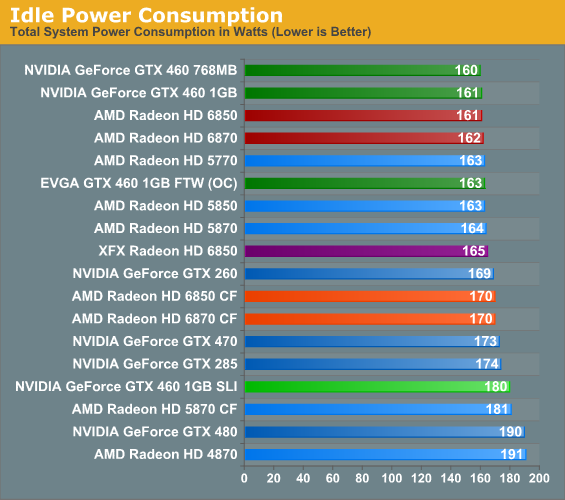
As always we start our look at power/temp/noise with our look at idle power. Because we use a 1200W PSU in our GPU test rig our PSU efficiency at idle is quite low, leading to the suppression of the actual difference between cards. But even with this kind of suppression it’s still possible to pick out what cards have a lower idle power draw, as the best cards will still result in a total system power draw that’s at least a couple of watts lower.
AMD’s official specs call for the 6800 series to have a lower idle power draw than the 5800 series, and while we can’t account for all 8 watts we do manage to shave a couple of watts off compared to our 5800 series cards. The Crossfire results are even more impressive, with the 6870CF drawing 11W less than the 5870CF.
Compared to the 6800 series the GeForce GTX 460 768MB does manage to hang on to top honor here for a single card by a watt, however in SLI our 1GB cards do worse than our 6800 series cards by 10W.
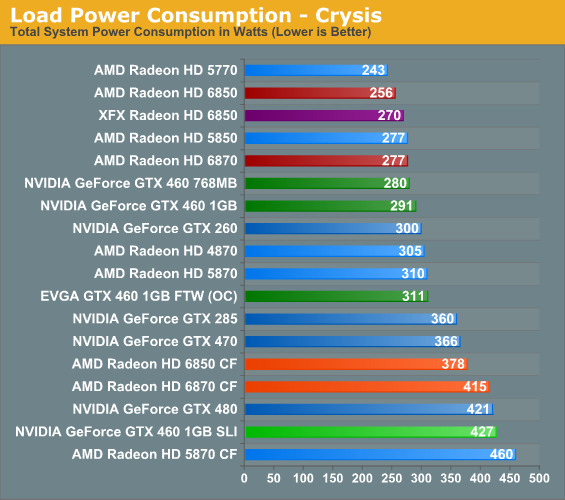
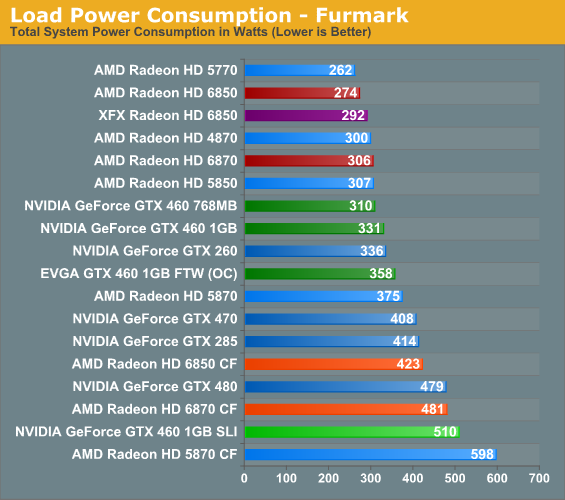
Looking at load power consumption it’s clear from the start that AMD’s efficiency gains are going to pay off here. On the latest iteration of our power consumption chart the 6850 underconsumes even the already conservative 5850 by 20W under Crysis and 25W under FurMark, showcasing how AMD was able to reduce their power consumption by a significant amount while giving up much less in the way of performance.
Compared to the 6800 series NVIDIA does notably worse here, with all of the GTX 460 cards pulling down more power than the 6870 and the GTX 470 being in a league of its own. While NVIDIA was competitive with Cypress on power, they’re not in a position to match Barts. They can deliver Barts-like performance (and then some), but they have to consume more power to do it.
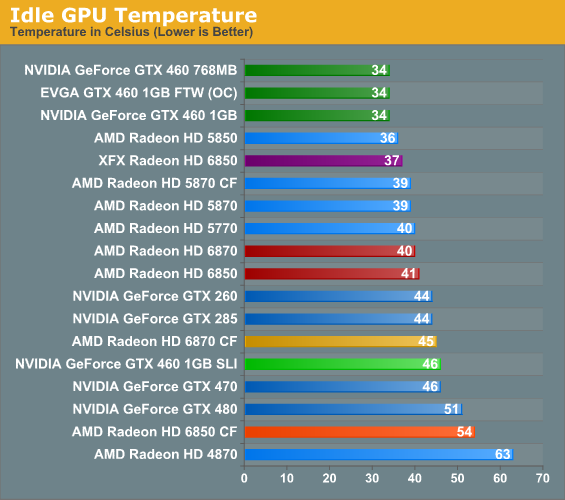
Up next is our look at GPU temperatures, starting with idle temps. As we mentioned in our GTX 460 review, NVIDIA ended up producing a very effective reference cooler for the GTX 460, utilizing an open-air design that by dissipating air inside and outside of the case is capable of reaching temperatures fully exhausting coolers can’t match. As a result all of the GTX 460 cards top our charts here.
Prior to the GTX 460 series this is a metric the 5850 always did well in, so we had expected a similar performance from the 6850, only to leave disappointed. What we’re ultimately looking at is a matter of the quality of the cooler: the 6850 may consume less power than the 5850 at idle, but it packs a weaker cooler overall, allowing it to approach these temperatures. For a gaming card such as the 6800 series idle temperatures are almost entirely superficial once we get below 50C, but even so this tells us something about the 6850 reference cooler.
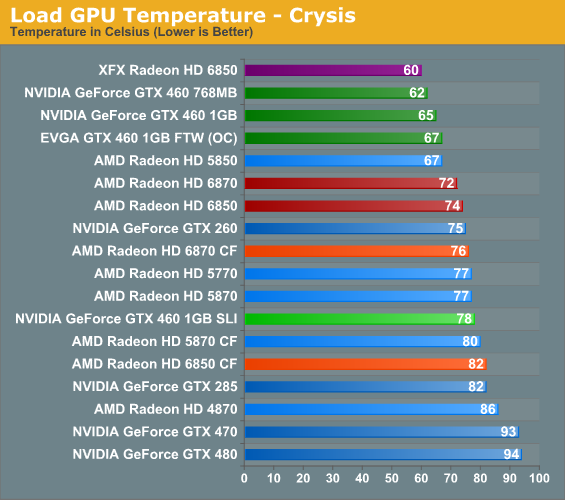
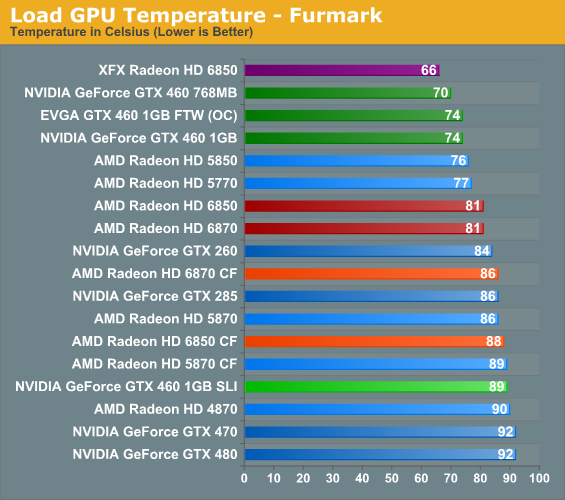
Thanks to the GTX 460’s open-air cooler, all of our GTX 460 cards top our temperature chart even with their higher power consumption. The trade-off is that all of these cards require a well-ventilated case, while the Radeon 5800 and 6800 series will tolerate much poorer cases so long as there’s enough ventilation for the card to pull in air in the first place.
As was the case with idle temperatures, the reference 6850 ends up doing worse than the 5850 here thanks to its less effective cooler; however the 6870 ends up doing better than both the 6850 and 5870 due to its more effective cooler and its lower power consumption compared to the 5870. While these cards can’t quite touch the GTX 460 series, we’re still looking at some of the coolest cards among our current benchmark suite.
Meanwhile our XFX 6850 ends up doing the best out of all of our cards here, however this will come at a cost of more noise. We'll touch on this more next week in our 6850 roundup.
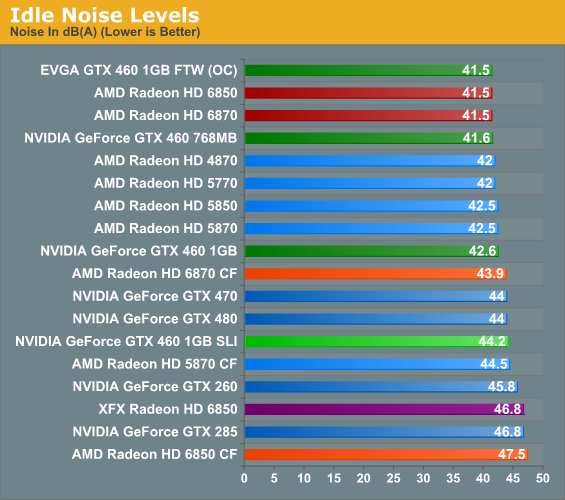
Last but not least is idle noise, which isn’t much of a story with modern cards. With the exception of the GTX 470/480, the latest GeForce and Radeon cards are both capable of running up against the noise floor of our testing environment.
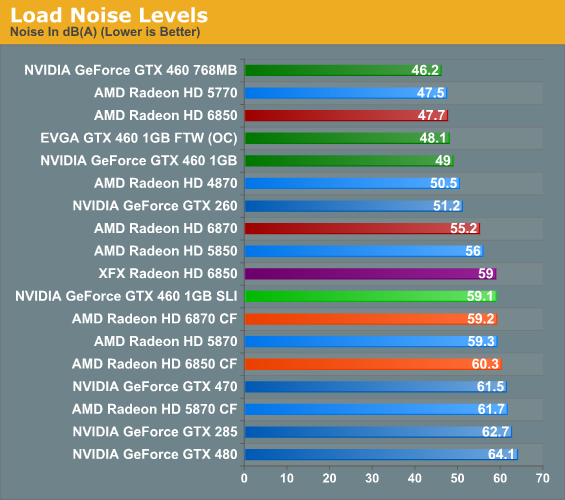
Under load we once again see an NVIDIA GTX 460 card top the chart thanks to its open-air design. This is followed very closely however by the Radeon 6850, which at 47.7dB is our third-quietest card and finally showing off the advantages of the tradeoffs AMD made with the reference cooler. The 6850 may not be as cool as the 5850, but it’s quite a bit quieter. As for the XFX card, this is where XFX has to pay the piper, as their 6850 card ends up being as loud as a 5870 in exchange for their lower temperatures.
Meanwhile the 6870 ends up being quite a bit louder than both the GTX 460 series and the 6850, coming in at 55.2dB. This is a definite leg-up compared to the 5870 and nicely cements the fact that the 6870 is intended to be the 5850’s replacement, but it means the GTX 460 series spoils the results here. Once custom-design vendor cards come out for the 6870, I suspect we’re going to see someone quickly sell a 6870 with a less aggressive cooler, which for the costs of higher temperatures would afford less noise.










197 Comments
View All Comments
GeorgeH - Friday, October 22, 2010 - link
WRT comments complaining about the OC 460 -It's been clear from the 460 launch that a fully enabled and/or higher clocked 460 would compete very well with a 470. It would have been stupid for NVIDIA to release such a card, though - it would have made the already expensive GF100 even more so by eliminating a way to get rid of their supply of slightly defective GF100 chips (as with the 465) and there was no competitive reason to release a 460+.
Now that there is a competitive reason to release one, do you really think Nvidia is going to sit still and take losses (or damn close to it) on the 470 when it has the capability of launching a 460+? Do you really think that Nvidia still can't make fully functional GF104 chips? Including the OC 460 is almost certainly Ryan's way of hinting without hinting (NDAs being what they are) what Nvdia is prepping for release.
(And if you really think AT is anyone's shill, you're obviously very new to AT.)
AnandThenMan - Friday, October 22, 2010 - link
"And if you really think AT is anyone's shill, you're obviously very new to AT."Going directly against admitted editorial policy doesn't exactly bolster your argument now does it. As for your comment about a 460+ or whatever you were trying to say, who cares? Reviews are supposed to be about hardware that is available to everyone now, not some theoretical card in the future.
MGSsancho - Friday, October 22, 2010 - link
A vendor could just as likely sell an overclocked 470 card as well as a 480. But I think you made the right assumption that team green might be releasing overclocked cards that all have a minimum of 1gb of ram to make it look like their cards are faster than team red's. maybe it will be for near equal price points, the green cards will all be 20~30% overclocked to make it look like they are 10% faster than the red offerings at similar prices. Red cards could just be sold over clocked as well (we have to wait a bit more to see how well they overclock). All of this does not really matter. In the end of the day, buyers will look at whats the fastest product they can purchase at their price point. Maybe secondly they will notice that hey this thing gets hot and is very loud and just blindly blaming the green/red suits and thirdly they will look at features. Who really knows.Personally I purchase the slightly slower products then over clock them myself if i find a game that needs it. I would rather have the headroom vs buying a card that is always going to be hot enough to rival volcanoes even if it is factory warrantied.
Golgatha - Friday, October 22, 2010 - link
The nVidia volcanoes comment is really, really overstated. I have a mid-tower case with a 120mm exhaust and 2x92mm intakes (Antec Solo for reference), and a GTX 480. None of these case fans are high performance fans. Under very stressful gaming conditions, I hit in the 80-85°C range, and Folding@Home's GPU3 client will get it up to 91°C under 100% torturous load.Although I don't like the power consumption of the GTX 480 for environmental reasons, it is rock solid stable, has none of the drawbacks of multi-GPU setups (I actually downgraded from a Crossfire 5850 setup due to game crashing and rendering issues), and it seems to be top dog in a lot of cases when it comes to minimum FPS (even when compared to multi-GPU setups).
Parhel - Friday, October 22, 2010 - link
"And if you really think AT is anyone's shill, you're obviously very new to AT"I think you're referring to me, since I'm the one who used the word "shill." Let me tell you, I've been reading AT since before Tom's Hardware sucked, and that's a loooong time.
If I were going to buy a card today, I'd buy the $180 GTX 460 1GB, no question. I'm not an AMD fan, nor am I an NVidia fan. I am, however, an Anandtech fan. And their decision to include the FTW edition card in this review means I can no longer come here and assume I'm reading something something unbiased and objective.
GeorgeH - Friday, October 22, 2010 - link
It was actually more of a shotgun blast aimed at the several silly posts implying AT was paid off by EVGA or Nvidia.If you've been reading AT for ~10 years, why would you assume that Ryan (or any other longtime contributor) suddenly decided to start bowing to outside pressure? If you stop lighting the torches and sharpening the pitchforks for half a second, you might realize that Ryan probably has a very good reason for including the OC card.
Even if I'm smoking crack WRT a GTX460+, what's the point of a review? It's not to give AMD and Nvidia a "fair" fight, it's to give us an idea of the best card to spend our money on - and if AMD or Nvidia get screwed in the process, I'm not going to be losing any sleep.
Typically, OC cards with a significant clock bump are fairly rare "Golden samples" and/or only provide marginal performance benefits without significantly increasing heat, noise, and power consumption. With the 460, Nvidia all but admitted they could've bumped the stock clocks quite significantly, but didn't want to threaten their other cards (*cough* 470 *cough*) if they didn't have to. This is reflected in what you can actually buy at Newegg - of the ~30 1GB 460's, only ~5 are running stock. 850MHz is still high, but is also right in line with the average of what you can expect any 460 to get to, so I don't think it's too far out of place.
Repeating what I said above, including the OC card was unfair to AMD, but is highly relevant to me and my wallet. I couldn't care less if AMD (or Nvidia) get screwed by an AT review - I just want to know what's best for me, and this article delivers. If the tables were turned, I'm sure that Ryan would have no problem including an OC AMD card in a Nvidia review - because it isn't about being a shill, it's about informing me, the consumer.
SandmanWN - Friday, October 22, 2010 - link
What? Put the crack down... Really, if you are short on time to review a product and you steal time away from that objective just to review a specially delivered hand selected opponents card instead of completing your assignment then you've not exactly been genuine to your readers or in this case to AMD.If you have time to add in an overclocked card then you need to do the same with the review card, otherwise the OC'd cards need to wait another day.
I have no idea how you can claim some great influence on your wallet when you have no idea of the OC capabilities of the 6000 series. If you actually bought the 460 off this review then you are banking that the overclock will hold up against a unknown variable. That's not exactly relevant to anyone's wallet.
GeorgeH - Friday, October 22, 2010 - link
An OC'd 460 competes with the 6870, and the 6870 doesn't really overclock at all.Even overclocked, a 6850 isn't going to touch a 6870, unless you're going to well over 1GHz (which short of a miracle isn't going to happen.)
It was disappointing that the review wasn't fleshed out more, but I'd say what's missing isn't as relevant to my buying decisions as how well the plethora of OC'd 460s compare to the 6870.
Parhel - Saturday, October 23, 2010 - link
"the 6870 doesn't really overclock at all"What? You're talking out of your ass No review site has even attempted a serious overclock yet. It's not even possible, as far as I know, to modify the voltage yet! We have no way to gauge how these cards overclock, and won't for several weeks.
"850MHz is still high, but is also right in line with the average of what you can expect any 460 to get to"
Now you're sounding like the shill. 850Mhz is not a realistic number if we're talking about 24/7 stability with stock cooling. No way.
GeorgeH - Saturday, October 23, 2010 - link
850MHz unrealistic? Nvidia flat out admitted that most cards are capable of at least ~800MHz (no volt mods, no nothing) and reviews around the web have backed this up, showing low to mid 800's on most stock cards, at stock voltages, running stock cooling. If you're worried about reliability, grab one of the many cards that come factory OC'd with a warranty.The 6870 doesn't now and never will overclock much at all, at least not in the way the 460 does. As with any chip, there will be golden sample cards that will go higher with voltage tweaks and extra cooling, but AMD absolutely did not leave ~20-25% of the 6870's average clockspeed potential on the table. The early OC reviews back this up as well, showing the 6870 as having minimal OC'ing headroom at stock voltages.
If you're waiting to compare the maximum performance that you can stretch out of a cherry-picked 6870 with careful volt mods and aftermarket cooling, you're going to be comparing it with a 460 @ ~950MHz, not ~850MHz.
As a guess, I'd say that your ignorance of these items is what led you to be so outraged at the inclusion of the OC 460 in the review. The magnitude of the OC potential of the 460 is highly atypical (at least in mid-range to high end cards), which is why I and many other posters have no issue with its similarly atypical inclusion in the review.